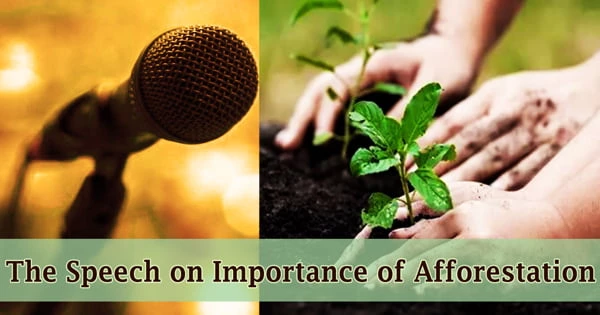A very Good Morning/Afternoon/Evening (Ladies and Gentlemen) to Honorable Principal Sir/Madam, respected teachers, parents, seniors, and my dear friends/students, Warm Greetings to Everyone!
Thank you all for taking out time and being present at this seminar session. Today, I ……(name) stand in front of you all to address a very important topic which is making a lot of news these days; I would like to speech on the topic of “Importance of Afforestation.”
Afforestation is a huge program of social forestry designed to fulfill the needs of local people for fuel, fodder, and timber, among other things. It restores the ecological balance of all ecosystems, maintains biological variety, and serves as catchments for all soil and water, as well as conservation, flood prevention, and tribal people’s future. We take down anything from 7 to 10 billion trees every year, and estimates suggest that there are close to 400 billion trees on the planet, so if you do the arithmetic, it won’t be long until we’ve cut down all of them, probably less than two lifetimes at most.
We cut trees for a variety of reasons. From the construction of our homes to the paper on which we take notes, trees are required, and many of us are unconcerned about the annual deforestation. Apart from the issue of trees simply running out, there are a slew of additional issues that come with mass tree removal, such as soil erosion, a lack of fresh air to breathe, a decrease in soil water retention, and so on. The industrial revolution, population explosions, and pollution affect the globe permanently, resulting in global warming and climate change.
Planting trees and growing forests help to reduce such causes that exploit natural resources and to extend the life of the world and its living species by increasing natural resources. As a result, afforestation is required to counteract global warming, soil erosion, pollution, and the preservation of biodiversity and ecological balances. There are two methods: afforestation and reforestation. Afforestation is the formation of new forest on previously unforested land, whereas reforestation is the reestablishment of forest cover, either naturally or artificially (manual planting of trees).
Afforestation is defined as “the conversion of barren or farmed land into the forest” by the Vocabulary. We will be able to reduce soil erosion if we implement afforestation. This, in turn, will aid in the preservation of soil fertility. As a result, it will benefit the agriculture industry. Furthermore, afforestation provides us with an abundant supply of lumber, fruit, feed, and other resources. It will lengthen the lives of our animals and improve crop yields. Furthermore, afforestation will improve water retention. Droughts can also be avoided by doing so.
Afforestation will help to achieve a forest cover of 33 percent of land in the future. Large-scale afforestation is urgently required. It entails tree protection and planting. Massive afforestation projects aid in the rapid growth of native and alien plants for production and forestry protection on appropriate areas, including wasteland. Afforestation, on the other hand, will aid in the protection of crops from excessive wind and sunshine. To put it another way, it will protect the crops from harm and aid in increased output.
Above all, tree planting is always a good idea. It’s not a bad idea to keep planting trees. They will aid in the regulation of carbon dioxide levels. A certain type of tree is typically in high demand in the business sector. Afforestation allows stakeholders to plant the sorts of trees that are in demand, allowing for faster tree proliferation. For example, the introduction of fresh tree supplies can assist to stabilize the cottage industry, resulting in steady pricing and company stability.
Planting trees to create new forests meets many of humanity’s business demands while causing no harm to the environment. As a result, afforestation is a technique that has been promoted by many nations’ governments and non-governmental organizations as a means of preventing over-exploitation of nature. Forests are lovely places, and millions of people visit them each year to marvel at their diversity. Afforestation results in the creation of new forests and, as a result, economic benefits. The more trees there are, the more beautiful the woods become, and the more people who visit them. This generates significant tourism revenue for governments.
Mangrove vegetation, a complex of plant communities covering large areas fringing sheltered The tropical coasts of South Asia are of exceptional ecological significance. Except for the rthern edge, which is being recovered, often illegally, the Sundarbans are valuable for agricultural production and are largely barren of human habitation since they are not available to settlement. This coastal woodland habitat stretches for roughly 120 kilometers inland. Coastal plantations, on the other hand, span an area of roughly 0.15 million hectares with mangrove species, mostly keoda and baen, and more than 8,000 ha of such land is planted each year. The coastal afforestation initiative also protects the environment against storms and their related storm surges and tidal bores. They also stabilize soil and make freshly accreted land viable for agriculture, in addition to supplying the needs for fuel and pulpwood.
We are all aware that trees play a vital role in air purification. People who live in locations with trees are less prone to suffer from breathing problems. Through photosynthesis, trees purify carbon dioxide and provide oxygen. Trees not only remove carbon dioxide from the atmosphere, but they also remove greenhouse gas emissions. They also trap dirt particles in the air, improving the quality of the air.
In a nutshell, we must promote afforestation. It will contribute to making the globe a more environmentally friendly place. Afforestation will also ensure the future of our future generations. Most significantly, people must recognize that it is we who will suffer if the necessary actions are not done. Earth will continue to exist as it has in the past; we must rescue ourselves. It is important to remember that one tree equals one life and that we must conserve them for our own protection. As a result, the only option for human existence is to rehabilitate forests and maintain a healthy forest cover and ecology.
Also, many thanks to you and everyone else who is here. It was a pleasure to speak with you.
Hope you all have a great time; Thank you all.
















